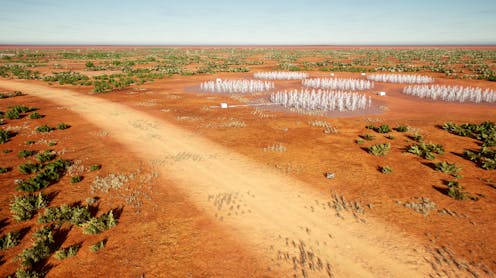In Australia and South Africa, construction has started on the biggest radio observatory in Earth's history
- Written by Cathryn Trott, Research Fellow in Radio Astronomy, SKA-Low Chief Operations Scientist, Curtin University

Construction of the world’s biggest radio astronomy facility, the SKA Observatory, begins today. The observatory is a global project 30 years in the making.
With two huge two telescopes, one in Australia and the other in South Africa, the project will see further into the history of the Universe than ever before.
Astronomers like me will use the telescopes to trace hydrogen over cosmic time and make precise measurements of gravity in extreme environments. What’s more, we hope to uncover the existence of complex molecules in planet-forming clouds around distant stars, which could be the early signs of life elsewhere in the Universe.
I have been involved in the SKA and its precursor telescopes for the past ten years, and as the chief operations scientist of the Australian telescope since July. I am helping to build the team of scientists, engineers and technicians who will construct and operate the telescope, along with undertaking science to map primordial hydrogen in the infant universe.
What is the SKA Observatory?
The SKA Observatory[1] is an intergovernmental organisation with dozens of countries involved. The observatory is much more than the two physical telescopes, with headquarters in the UK and collaborators around the world harnessing advanced computers and software to tailor the telescope signals to the precise science being undertaken.
The telescope in South Africa (called SKA-Mid) will use 197 radio dishes to observe middle-frequency radio waves from 350 MHz to more than 15 GHz. It will study the extreme environments of neutron stars, organic molecules around newly forming planets, and the structure of the Universe on the largest scales.
Read more: Aspiration vs delivery: the long road to the Square Kilometre Array[2]
The Australian telescope (SKA-Low), in Western Australia, will observe lower frequencies with 512 stations of radio antennas spread out over a 74-kilometre span of outback.
The site is located within Inyarrimanha Ilgari Bundara[3], the CSIRO Murchison Radio-astronomy Observatory. This name, which means “sharing sky and stars”, was given to the observatory by the Wajarri Yamaji, the traditional owners and native title holders of the observatory site.
Tuning in to the Universe
After decades of planning, developing precursor telescopes and testing, today we are holding a ceremony to mark the start of on-site construction. We expect both telescopes will be fully operational late this decade.
Each of the 512 stations of SKA-Low is made up of 256 wide-band dipole antennas, spread over a diameter of 35 metres. The signals from these Christmas-tree-shaped antennas in each station are electronically combined to point to different parts of the sky, forming a single view.
These antennas are designed to tune in to low radio frequencies of 50 to 350 MHz. At these frequencies, the radio waves are very long – comparable to the height of a person – which means more familiar-looking dishes are an inefficient way to catch them. Instead the dipole antennas operate much like TV antennas, with the radio waves from the Universe exciting electrons within their metal arms.
Collectively, the 131,072 dipoles in the completed array will provide the deepest and widest view of the Universe to date.
Peering into the cosmic dawn
They will allow us to see out and back to the very beginning of the Universe, when the first stars and galaxies formed.
This key period, more than 13 billion years in our past, is termed the “cosmic dawn”: when stars and galaxies began to form, lighting up the cosmos for the first time.
Read more: After our universe's cosmic dawn, what happened to all its original hydrogen?[4]
The cosmic dawn marks the end of the cosmic dark ages, a period after the Big Bang when the Universe had cooled down through expansion. All that remained was the ubiquitous background glow of the early Universe light, and a cosmos filled with dark matter and neutral atoms of hydrogen and helium.
The light from the first stars transformed the Universe, tearing apart the electrons and protons in neutral hydrogen atoms. The Universe went from dark and neutral to bright and ionised.
The SKA Observatory will map this fog of neutral hydrogen at low radio frequencies, which will allow scientists to explore the births and deaths of the earliest stars and galaxies. Exploration of this key period is the final missing piece in our understanding of the life story of the Universe.
Unimagined mysteries
Closer to home, the low-frequency telescope will time the revolutions of pulsars. These rapidly spinning neutron stars, which fire out sweeping beams of radiation like lighthouses, are the Universe’s ultra-precise clocks.
Changes to the ticking of these clocks can indicate the passage of gravitational waves through the Universe, allowing us to map these deformations of spacetime with radio waves.
It will also help us to understand the Sun, our own star, and the space environment that we on Earth live within.
These are the things we expect to find with the SKA Observatory. But the unexpected discoveries will most likely be the most exciting. With an observatory of this size and power, we are bound to uncover as-yet-unimagined mysteries of the Universe.
References
- ^ SKA Observatory (www.skao.int)
- ^ Aspiration vs delivery: the long road to the Square Kilometre Array (theconversation.com)
- ^ Inyarrimanha Ilgari Bundara (research.csiro.au)
- ^ After our universe's cosmic dawn, what happened to all its original hydrogen? (theconversation.com)














